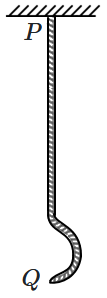If the absolute temperature increases by \(1\%\), the frequency of an organ pipe will:
1.
increase by \(1\%\)
2.
decrease by \(1\%\)
3.
increase by \(0.5\%\)
4.
decrease by \(0.5\%\)

To unlock all the explanations of this course, you need to be enrolled.

To unlock all the explanations of this course, you need to be enrolled.

| 1. | increases | 2. | decreases |
| 3. | first increases and then decreases | 4. | remains constant |

To unlock all the explanations of this course, you need to be enrolled.

To unlock all the explanations of this course, you need to be enrolled.
1. \(30\sqrt2\) dB
2. \((60+\sqrt2)\) dB
3. \(57\) dB
4. \(60\sqrt2\) dB

To unlock all the explanations of this course, you need to be enrolled.

To unlock all the explanations of this course, you need to be enrolled.
| 1. | \(x= 0~\text{cm}, 10~\text{cm}, 20~\text{cm},....\) |
| 2. | \(x= 0~\text{cm}, 20~\text{cm}, 40~\text{cm},....\) |
| 3. | \(x= 5~\text{cm}, 10~\text{cm}, 15~\text{cm},....\) |
| 4. | \(x= 5~\text{cm}, 15~\text{cm}, 25~\text{cm},....\) |

To unlock all the explanations of this course, you need to be enrolled.

To unlock all the explanations of this course, you need to be enrolled.

| 1. | \(A\) | 2. | \(\sqrt 2A\) |
| 3. | \(2A\) | 4. | \((2+\sqrt2)A\) |

To unlock all the explanations of this course, you need to be enrolled.

To unlock all the explanations of this course, you need to be enrolled.
| 1. | \(1\) | 2. | \(1/2\) |
| 3. | \(2/3\) | 4. | \(3/2\) |

To unlock all the explanations of this course, you need to be enrolled.

To unlock all the explanations of this course, you need to be enrolled.
| 1. | its internal energy |
| 2. | its internal energy per unit volume |
| 3. | its internal energy per unit mass |
| 4. | its internal energy per unit temperature |

To unlock all the explanations of this course, you need to be enrolled.

To unlock all the explanations of this course, you need to be enrolled.
| 1. | \(\dfrac{ 1}{2L} \sqrt {\dfrac{T}{m}}\) | 2. | \(\dfrac{1}{4 L} \sqrt{\dfrac{T}{m}}\) |
| 3. | \(\dfrac{1}{2} \sqrt{\dfrac{TL}{2m}}\) | 4. | \(\dfrac{1}{2} \sqrt{\dfrac{T}{m L}}\) |

To unlock all the explanations of this course, you need to be enrolled.

To unlock all the explanations of this course, you need to be enrolled.
| 1. | \(2^{\text{nd}}\) harmonic | 2. | \(3^{\text{rd}}\) harmonic |
| 3. | \(6^{\text{th}}\) harmonic | 4. | \(12^{\text{th}}\) harmonic |

To unlock all the explanations of this course, you need to be enrolled.

To unlock all the explanations of this course, you need to be enrolled.
At which points is the amplitude equal to \(2\) mm?
| 1. | \(x = \) \(10\) cm, \(20\) cm, \(30\) cm, \(40\) cm |
| 2. | \(x=\) \(10\) cm, \(15\) cm, \(30\) cm, \(45\) cm |
| 3. | \(x =\) \(10\) cm, \(20\) cm, \(40\) cm, \(80\) cm |
| 4. | \(x = \) \(10\) cm, \(20\) cm, \(40\) cm, \(50\) cm |

To unlock all the explanations of this course, you need to be enrolled.

To unlock all the explanations of this course, you need to be enrolled.






